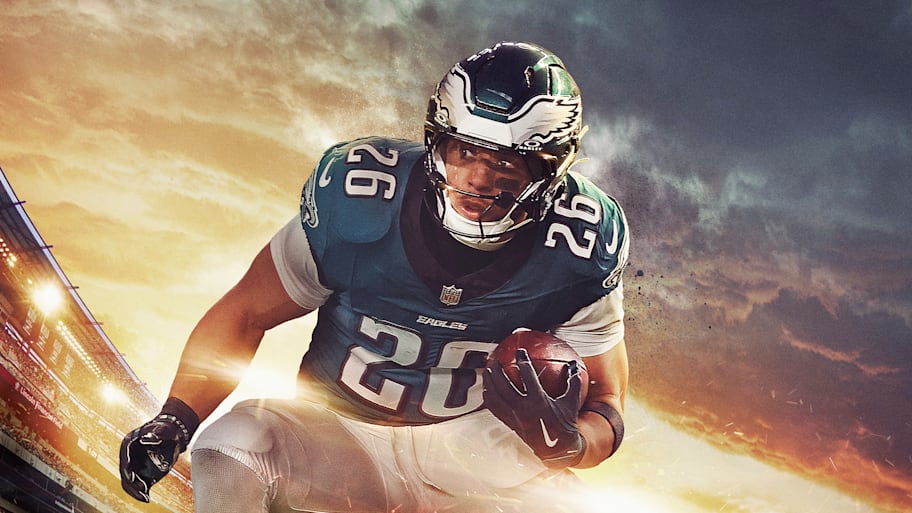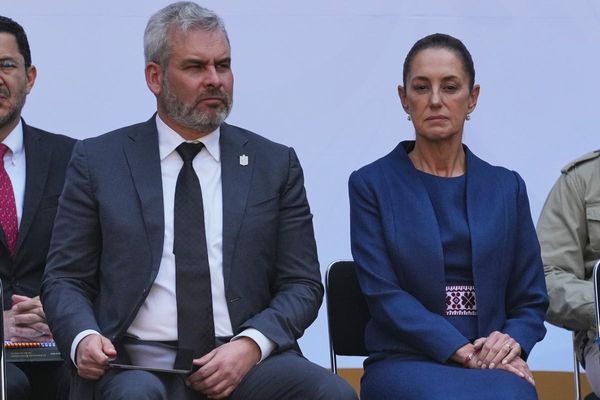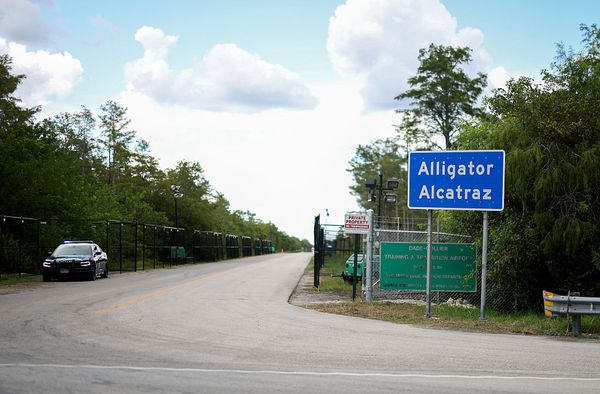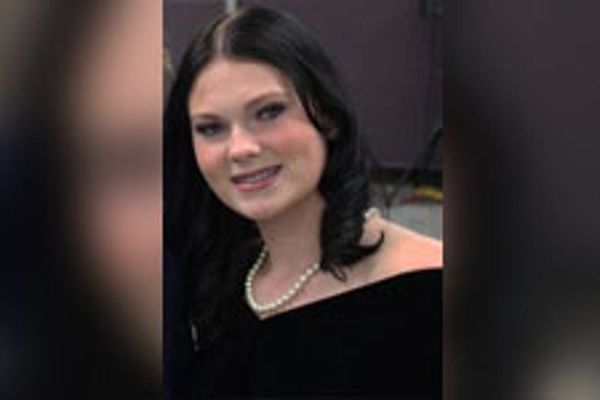

Saquon Barkley wants you to forget about this so-called running backs resurgence. Instead, he’d like to reframe the positional narrative entirely, adding overlooked significance, despite recent and pervasive acceptance of the exact opposite notion: that NFL executives had/have given up on ballcarriers as anything more than necessary but disposable parts—the football equivalent of takeout containers or medical gowns.
Barkley presents Barry Sanders, his favorite back, as a counter to that argument. The creativity! That flair! The turning, full 360-degree pivots, before running the wrong way, on purpose, all simply to create a window, just a sliver of open field, to dance through and dart past. This style wasn’t coachable, and that’s what still appeals to Barkley. “Saquon tries to mimic [Sanders],” says Micah Parsons, the Cowboys’ All-Pro pass rusher and Barkley’s close friend. “How he carries it. Like him.”
In Sanders and Barkley, Parsons sees differing styles, the cannot-be-replicated kind, borne from genetics, training and mastery of a specific, not-endangered skill set.

On the second day of training camp, Barkley’s eyebrows shoot up during an interview with Sports Illustrated. Those brows, they scream, Really? He points to one story from Sanders’s football lore, when the high school coach who didn’t love Sanders’s style didn’t fully embrace it. “Imagine that!” the Eagles’ running back says.
Watch Barkley against Jacksonville last season. That half spin—back pointed toward the defense, tackler closing in—and then … his leap, perhaps the one play that best defined a season in which a running back unleashed his specific brand of dominance to imprint a Super Bowl championship.
never seen this before. @Saquon
— NFL (@NFL) November 3, 2024
📺: #JAXvsPHI on CBS/Paramount+
📱: https://t.co/waVpO909ge pic.twitter.com/L5AiVkkyvf
Two long jumpers who competed in past Olympics saw the physics of their athletic movement in this play, only applied to the football. Both train with Barkley’s speed coach, Ryan Flaherty. They asked him to approach Barkley, hoping he’d attempt a real long jump, to ascertain how far he might fly without training.
Consider that—the deployment of football skills unrelated to football in yet another “only Saquon” greatness sequence. Then use the word extinct.
Here, Barkley sounds like Neil deGrasse Tyson, the famed astrophysicist, from a well-circulated interview clip. He speaks of genius, in the most eccentric artists, such as Vincent van Gogh (cut off an ear) or Beethoven (poured water over his head while composing), and posits that their brilliance wouldn’t be so obvious if their processes weren’t so different from everyone else’s. If they weren’t artists. Those who teeter where brilliance and madness intersect often ply their artistry in ways only they can. Their genius could never be replicated.
As a counterpoint, Tyson invokes Albert Einstein, another genius who changed the world. But while there would have been no The Starry Night without van Gogh, Tyson argues, someone probably would have eventually come up with Einstein’s theory of relativity.
The running back resurgence applies to nongenius players as well as the Einstein types. Barkley still has both ears. He will enter 2025 as healthy as he has felt in years. But his genius is their genius, the uncommon, sometimes uncomfortable, variety.
“We are artists,” Barkley says. “That’s the running back position. It’s art. I don’t think anyone can create a better [body of work] than Barry Sanders. The best artist of all time.”
At least, before the 2025 season.
Classic Barkley, by the way. The man who majored in communications at Penn State has taken that deeper understanding—of narratives, storytelling, journalism—and examined each in stories that touch him. Barkley can say that his narrative has unspooled like a movie adaptation. Based on a true story. His. But these labels—injury-prone; old; past his prime; an oxymoron, superstar running back—lack context that’s critical to any evaluation.
He doesn’t wish those tags would vanish. He’s also not going to simply agree with them. Barkley believes that his foremost allegiance, after his own team, is to football. For example, with his heart set on “going back” to New York until the Giants decided to move on from him after the 2023 season, Barkley defended divisive QB Daniel Jones to members of his inner circle. Barkley considers Jones “one of the best quarterbacks in the league.”
“My loyalty, in those conversations about Daniel, is to the game,” Barkley told SI in February. “I don’t see [backing Jones] as being loyal. If I thought he was trash, I’d say he’s not good. It’s not like I’m blowing smoke. I was around him. I know the work he put in. Did he struggle at times? Yeah, we all did there. But you see a lot of guys—and this isn’t a knock on the Giants, it’s not just that organization—but all around you see guys who may be at one place and struggle, and they go to another place and thrive.”
That’s the narrative Barkley fashioned in 2024. But it’s not the narrative he must fashion now: another season, another year of (relative) healthy football. If all goes well, perhaps another romp through the record books. But none of that matters to him without the ending that gives everything else significance: another Super Bowl victory.

Barkley celebrated more than his first NFL championship last Feb. 9. He turned 28 the same day, and friends rented space in a New Orleans restaurant for food, drinks and a celebration very few humans will ever understand. “I don’t think there’s a better way to celebrate than [doing it as] a Super Bowl champion,” he says.
The afterglow hardly even radiated. The next night, Barkley flew home to Philadelphia. Thousands of Eagles diehards were waiting at the airport.
Hours later, Barkley went to bed but couldn’t sleep, his mind spinning. “Think about a movie,” he says, “where everything just flashes quick.” His years with the Giants. His new team. The philosophical shift toward the run game after four weeks. His deployment. The Leap. The snow game. The record for most yards from scrimmage in a single NFL season, including the playoffs (2,857). Wanting to play in the regular-season finale, as he told me in February, to at least aim at Eric Dickerson’s single-season rushing mark (2,105 yards in 1984). NFL Offensive Player of the Year honors. Super Bowl LIX. Confetti. Happy birthday to Saquon!
Just think: Barkley left a less talented roster in New York. He went to Philadelphia, assuming the risk of, essentially, a one-year contract for the most skilled and deepest team he had ever played on.
He wasn’t disposable. But he didn’t win all by himself, either. It was mutually beneficial. The Eagles’ title and Barkley’s best NFL season don’t exist without each other. His rushing yards over expected per carry (+1.62, second best in the NFL) speaks to an offensive line that ranks among the league’s best. His ESPN catch score (66, third best among RBs) speaks to his position’s evolution. His breakaway runs (25, best in the NFL) highlight what he added, his style, in his seventh season, versatile, workhorse-like and explosive.
Alas, no single-season rushing mark.
And?
The corresponding realization dawned that same night. Now what?
Barkley reminded himself of what he always says, the same phrase that explains so much of him and the past seven NFL seasons. Chill-chill. That’s it. That saying applies when a franchise gives up on its cornerstone, for events far beyond the cornerstone’s control. And it applies to chasing 2,000-plus yards rushing in a season. He will not do that this year, unless another opportunity grows organically. Instead, that phrase.
Chill-chill.
Artistry over accolades.
Barkley assesses the obvious choices for the single-best running back season in NFL history. He takes about as much time to answer as he might to leap, backward, over a defender. He doesn’t choose Dickerson’s record setter, nor Terrell Davis’s 1998 campaign, when the Broncos’ back rushed for 2,008 yards and 21 touchdowns in an MVP season that ended with Denver winning Super Bowl XXIII.
He doesn’t even pick his own best season in this exercise. And what a year: 2,005 rushing yards, while sitting out Week 18; league highs in carries (345) and yards per game (125.3); 499 postseason rushing yards; and the Super Bowl I-told-you-so.
No, Barkley chooses Sanders. In 1997, Big Bad Barry managed just 53 yards rushing in the first two weeks. He topped 100 in every subsequent game, with two over 200. In those split seconds, Barkley computes Sanders’s totals, minus the slow start: 14 weeks, 2,000 yards. “Insane,” Barkley says. “Probably never gonna see it again.”
Barkley wants to apply logic to the narrative of modern RBs. He spies a false premise baked into the resurgence construct. It presupposes there weren’t talented backs—or that many of them—as the position’s compensation plummeted. It seemed like no franchise wanted to pay a ballcarrier anything beyond … less money. The teams that did, Barkley notes, won titles.
So, what resurgence? That’s Barkley’s analysis, as he shifts the conversation. “I’m super confident in myself,” he says. “And I’m the best in the NFL.” (Another pivot. “Do I think I’m the most talented one right now?” Pause. “I don’t. Bijan [Robinson] is the most talented. Puts it all together.” In addition to the Falcons’ third-year star, Barkley cites the Lions’ Jahmyr Gibbs.)
As for the compensation plummet, Barkley believes it really owes to little more than “three to four” backs whose franchises doled out massive contracts—before injuries sidelined all of them. “Now, you have owners and GMs trying to find great players for cheaper value,” he says. “That’s what it all was. I got tagged. Josh Jacobs got tagged [by the Raiders].”
He adds, quickly, stiff-arming any potential controversy, “I’m not going to sit here and say there was colluding. I’m not going into all that. But football is football. If you cannot run the ball, you’re done.”
Barkley anticipates the counterargument and attacks before it can be voiced. The NFL is a passing league. He knows that. Everyone knows that. But he also suggests taking a deeper look at Kansas City.
He’s spot-on. In Super Bowl LIV, after the 2019 season, the Chiefs controlled the game clock with 129 yards rushing (victory over San Francisco). In Super Bowl LVII, after the ’22 season, they gashed the Eagles for 158 yards rushing. In their title repeat the next year, another win over the 49ers, Kansas City accumulated 130 yards rushing the old-fashioned way in a modern setting—three yards and no cloud at all.
Compare the Chiefs’ rushing output in the Super Bowls they lost—49 last February and 107 in their thrashing at the hands of Tampa Bay in 2021. That K.C. delivered its title runs absent a superstar back doesn’t diminish Barkley’s argument. The difference between three championships and five comes down, in large part, to how the Chiefs ran the football on any given Super Bowl Sunday.
Those quick to trot out Barkley’s tame (also relative) statistics from Super Bowl LIX miss what matters. The Eagles had 45 carries and 135 yards rushing that evening. Only 57 yards came from Barkley. But the time of possession gap ballooned, in favor of the Eagles, 36:58 to 23:02.
Just try and win a championship without a stud back or a strong collective, without those who eat game clock for breakfast, set tones in indelible black ink, punish defenses, snag receptions, block, fake and feint. Just ask the Chiefs.
Better yet, ask the Giants.
To be lumped into this “resurgence” strikes Barkley as disrespectful. He’s never voiced this publicly before. “[It] wasn’t, like, a diss to just me,” he says. “It’s something they were trying to make up, just so they can get players for cheaper value. And, if you make that argument for running backs, you can do that for any position in the NFL.”

Once he gets rolling on perceptions and misconceptions, Barkley can’t slow down. Next up: his impact on the Eagles, which he views as vast and historic, while also overstated.
Did Philly triumph because general manager Howie Roseman made Barkley his top priority in free agency? Because head coach Nick Sirianni ceded control over the game plan to offensive coordinator Kellen Moore? Because, during the Week 5 bye, Moore adjusted the scheme toward more carries for Barkley? Because of Jalen Hurts’s MVP performance in the Super Bowl? Because of the tush push?
The answer to all those questions is yes. No factor in the Eagles’ championship run failed to matter.
Barkley’s proudest accomplishment, he says, starts with how well he blocked. The extension Barkley signed this offseason—two years, $41.2 million, $36 million guaranteed— didn’t stem from that overlooked skill. Barkley’s buy-in, though, was absolutely factored in. Parsons can vouch for this improving blocking talent—not that he’s ever experienced it firsthand. Barkley, Parsons jokes, “is smarter than that.”
The two players share an understanding that’s limited to athletes who have come to dominate their sport. But it doesn’t mean they see their excellence as anything special. Watch Barkley watch himself. He hardly reacts to his own highlights from last season, appearing almost disinterested.
He isn’t trying to come across that way. Like the Leap, for example. He watched the tape, and, at first, the sequence amazed him. But that’s because he can hardly remember the sequence at all. “It feels like it happened a year or two ago,” he said back in February.
His focus is forward. Last season, the Eagles proved that they could adapt and that adapting was enough, with their collection of talent, to obliterate the Chiefs in Super Bowl LIX.
This season, to go back, let alone win again, they’ll have to embrace even more of the same concept. Moore is now the head coach in New Orleans. Important players departed the franchise in free agency: Josh Sweat (2.5 sacks in Super Bowl LIX) joined Arizona’s rebuild, Milton Williams (two sacks and a fumble recovery in the Super Bowl) went to New England, and the Eagles also lost other key contributors (offensive lineman Mekhi Becton, defensive backs Darius Slay and C.J. Gardner-Johnson, et al.)
Barkley says his top-tier wide receiver teammates, A.J. Brown and DeVonta Smith, sometimes tell him to put on his Superman cape. The critical part is not donning it to stray from a game plan or to accumulate statistics. “The Super Bowl is a prime example,” Barkley says. “I’m not getting off. And I’m not gonna go to the sideline and be like, ‘We gotta do this [differently].’ That’s the beauty of the team we had last year. And that’s what we need to focus on and build on. No matter who it is. No matter how it looks. It will look different. That’s why you come to a team like this.”
Parsons predicts another told-you-so campaign. “The Giants never really built around him,” Parsons says. “He’s ready to show people how good he is. He didn’t forget all the people who [were], like, ‘Nah, bro, Saquon’s washed up.’ ”

For all the fair but over-blown injury concerns—overblown, at least, to Barkley and his trainers—his worst injury should actually offer hope for the year ahead. It happened on Sept. 20, 2020, the day Barkley obliterated his right knee in an unholy trinity of tears or sprains (ACL, meniscus and MCL). Many close to him worried he’d never play football again. Doctors didn’t rule that out.
Many reports this offseason devoted vague paragraphs to Barkley’s reduced workload. He did, in fact, moderate his training from February to the start of training camp. But his reduction, Joe on the elliptical, is not the same as yours.
Barkley counts four “big” medical issues in his seven seasons. They’ve cost him 24 games, total, or 20.7% of his regular-season career. He touched the ball 345 times last year. The implication, then, is that his body won’t hold up from that combination of workload and a propensity for getting hurt. But examine those injuries, in more than a cursory way—rolled ankles, bad timing, stepping on a defender’s foot as Barkley pulled up on his route. No pattern. No lingering structural deficiencies. No less than full recoveries each time.
This season, Barkley says emphatically, marks the beginning of his prime and his second season surrounded by teammates who can carry teams and don’t need him to. He takes issue with the whole concept of an athletic prime, too. He points to Curtis Martin, Walter Payton, Emmitt Smith and Fred Taylor, to name four examples of running backs who turned in their best seasons at or around his age.
“That [past prime] notion is so funny,” Barkley says. “It’s bunk, all the running-back-position-is-dying [stuff]. You got wide receivers who [teams] pay all this money to, and when they get into their 30s, they’re not performing at the highest level; you just never hear that. How many quarterbacks can you name who played into their later 30s? Everyone’s not Tom Brady. They have to let that go!”
Barkley notes his progress, how he learned and evolved as the football world began doubting whether his future would ever match his expectations. Barkley compares his early-career style to that of a young Mike Tyson. “Just trying to hit home runs. Trying to knock you out.” Now, he says, he’s more like Floyd Mayweather Jr. in the end. Picking spots. Wearing out opponents. Not wasting energy that’s better to conserve. “And then, when the time comes, when you slip, I still have the power and speed to take it to the house,” Barkley says.
This spring, Barkley scribbled down four goals for this season. (His uncle, the boxer Iran Barkley, used to tape his goals list to the bathroom mirror, so he would see them when he brushed his teeth.) Only one had anything to do with football. He won’t cop to what it was, but it seems obvious: Lombardi or bust.
Last February, Barkley revealed the depths of his change-the-narrative campaign. At the suggestion of the Eagles’ team psychologist, he started doing visualization exercises before games. He pictured himself in an old cave, in front of a large waterfall, near a panther. He would transform into that, a panther but no ordinary panther. Barkley became the Black Panther.
That process extends into this season. But in a different, big cat–adjacent kind of way. “I’m trying to tap more into my Tiger side,” Barkley says. “My Eldrick side, I guess.” Yes, the golfer. Barkley wants to emulate turn-of-the-century Tiger Woods. No longer a prodigy, Woods topped the money list and won PGA Tour Player of the Year in 1999. The next year, Tiger somehow elevated, winning three majors in the greatest season in golf history. “Just being on the prowl,” Barkley says. “People automatically associate a hell of a year with numbers. That’s not what’s driving me.”
Anyone who wants to know what is, well, all they have to do is ask. Otherwise, it’s chill-chill, same as always and like never before.
More NFL From Sports Illustrated
This article was originally published on www.si.com as Saquon Barkley Opens Up About 2,000 Yards, the Super Bowl and What’s Next.







